Since the container was not available this morning, the packing of spare parts continued in earnest.
Over fifty large boxes of parts were brought down the stairs from the stockroom today. Some of these boxes were then packed into open spaces in the transmitters. Again, a list was made of the number of each box going into each transmitter to facilitate locating these parts when they are needed later.
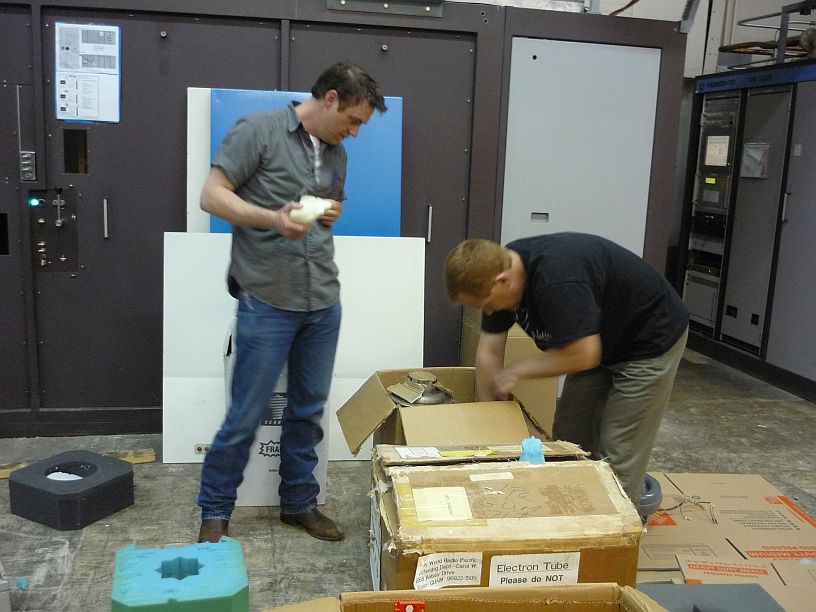
Jason and Grant carefully pack each tube after it is removed from the transmitter. They are extremely fragile and cost about $20,000 each new. The two newest transmitters (Thompson 250,000-watt shortwave) are in the background.
The first container finally arrived about 11am, but the shipping company did not follow instructions to have it on a special trailer that could lower the container onto the ground. We do not have the equipment available to hoist 3-ton transformers and 3-ton transmitter cabinets five feet into the air safely, then push them into the container.
After a couple of hours trying to sort the problem out over the phone, the trailer with container was left and the driver was to come back with the properly equipped truck to do the job.
Since things had slowed down because of the container delay, I decided to the extra time to raise Transmitter 1 (TX1) onto blocks so that it would be all ready to go onto the ‘skates’ after the rollers were no longer needed for TX2.
The truck driver had not returned by the end of the day. When the shipping company was called, we were informed that the driver would be on site tomorrow again at the same time as today!
[My computer was out of commission for a while, but, with our son’s help via email, it was possible to get it running again and back to doing our blog — Thanks, Allan!!]
With Transmitter 1 (TX1) all taken apart, today we began the final dismantling of TX2 by getting its top frame ready to come off. Unfortunately, we can not take the frame off until the containers arrive because there is no more floor space left to put more large parts. We were able to find room to remove the tubes.
We raised TX1, weighing around 3 ton, about 4″ and put it on ‘skates’ [special rollers] then moved it to the center of the transmitter hall in preparation for moving it out of the building.
Now we removed the two feedline ducts that carried the signal from the transmitter to the outside wall of the building where it attached to the open wire feedline. This proved a challenge because they are about 25 feet long and 15 feet above the floor, but we got it done!
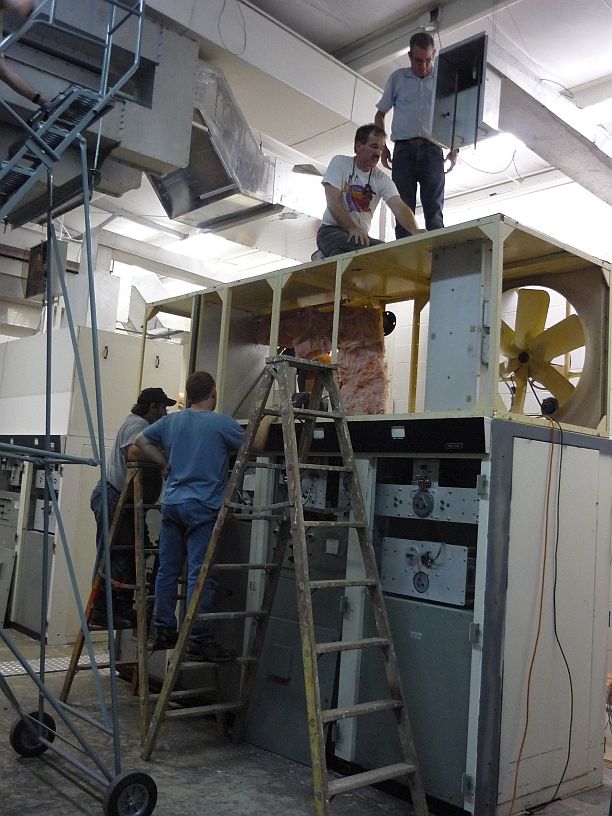
The feedline duct that was removed is just in front of Larry, goes through one wall then to the outside wall about 12 feet beyond the first wall. Overall length was about 25 feet. For the other feedline duct we did not have the ‘luxury’ of working off the top of the transmitter, like this one, but had to work off of ladders to pull it through, then lower it to the floor.
George and his coworker, Jason who arrived today, began packing spare parts while Virginia made sure the outside of each box was numbered and labeled with what parts were inside. She then made sure this information was transferred onto a summary sheet This kept them quite busy all day.

Virginia making a list while Jason packs spares. Jason is from Colorado and when he found out we we also originally from Colorado, he asked “Do you ever get used to this humidity??!” Virginia simply replied, “No!!”
Although the first of two 40-foot containers was supposed to be delivered today, by mid-afternoon there was still no sign of it arriving. It would be nice to have both containers at once, but there does not look like there is enough room to sit two on the ground at the same time and have both opening onto the concrete pad. With the heavy equipment being moved into the container, there needs to be a firm surface for either rollers and/or a forklift considering the frequent showers that we are having.
Mike eventually called the shipping company and was told the container would arrive at 7:30am tomorrow. Later they phoned back to say it would arrive no later than 10:30am tomorrow!
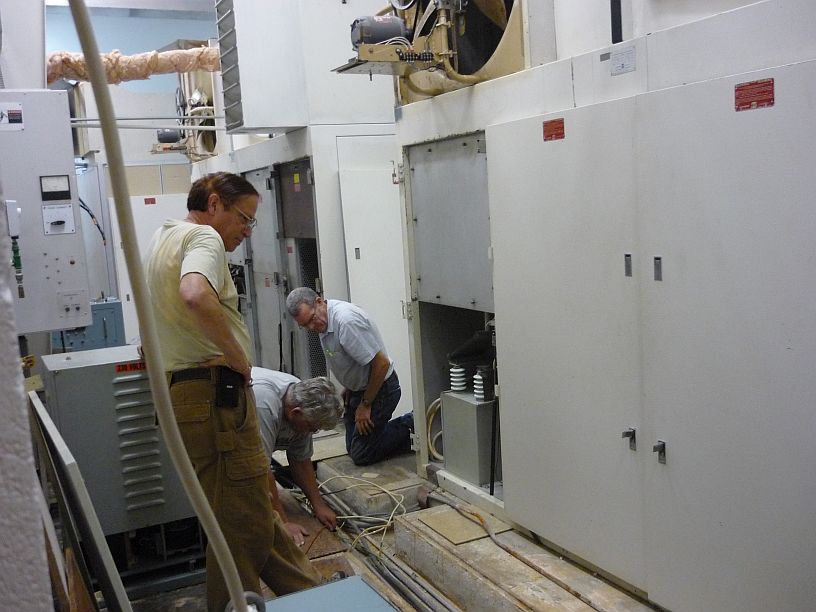
We spent a lot of time tracing , disconnecting and labeling wires. From left to right — George, Tom and Larry
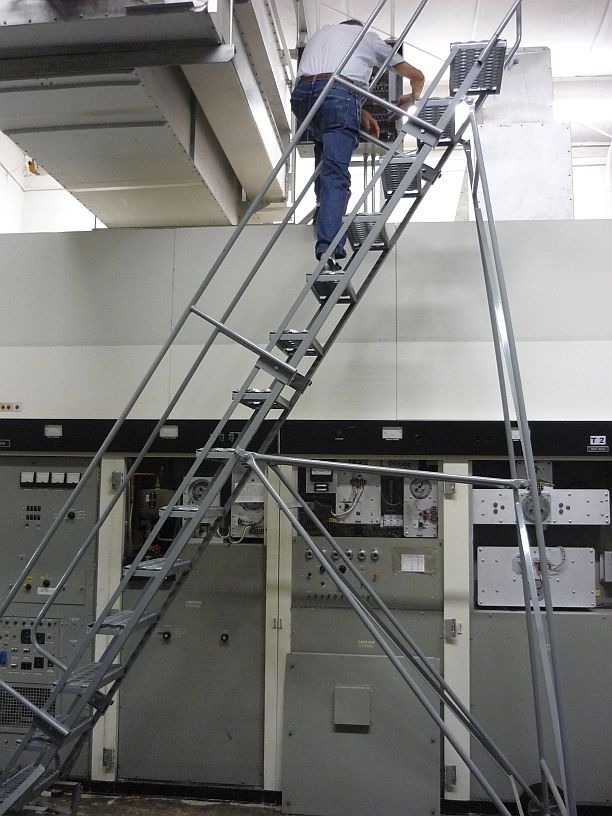
Larry disconnects the interconnecting wires for the panel that allows the transmitter to be controlled via a remote computer.
After labeling and removing much wiring, plumbing and ducting, we were able to remove the top structure above Transmitter 2.

Mike and Larry have removed the VHF filter between the top of the transmitter and the feedline. Jim and Grant remove the screws that fasten the top frame to the transmitter.
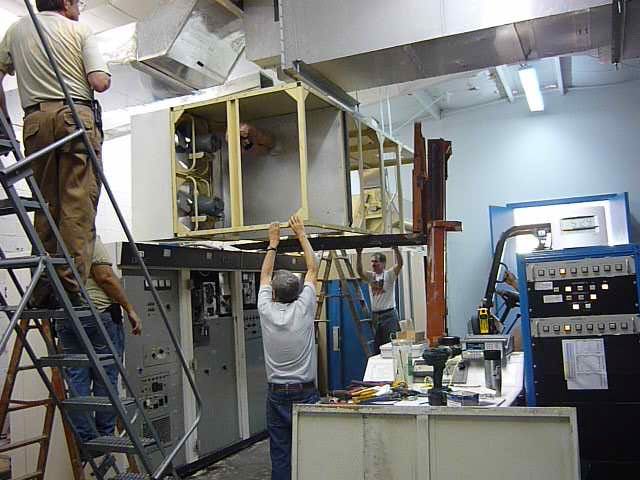
After hours of work by several men, the top frame is now being removed with the aid of the forklift.
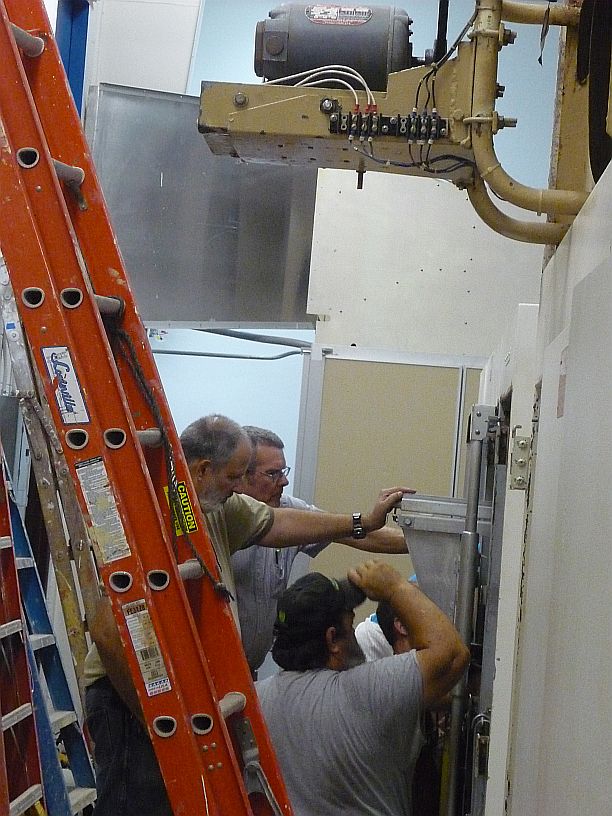
One of the last things done before lifting the transmitter onto rollers is the the removal of all five tubes. The two heaviest ones require the use of a special frame with a hydraulic jack.
One of two 40-foot containers was supposed to arrive this afternoon, but did not come.
When we got home this evening, we collected our empty 5 gallon jug and went to the Water Store. This is the second refill we have gotten since moving into the apartment.
Before we left Elkhart, we ordered anti-rejection medicine for Virginia’s transplanted cornea in plenty of time to get it before we departed for Guam. For some reason, the medicine was delayed and, as a result, got caught in the forwarded mail to our son Allan. [We are having our mail forwarded to him while we are gone.] For some unknown reason, it got returned to the mail order pharmacy. [My medicine sent later had no problem with the mail forwarding to Allan] We ended up calling our mail order pharmacy on Saturday, using Skype, and they agreed to resend it as quickly as possible. Early this morning, we checked the pharmacy website and were surprised to see that the medicine was due to arrive within a few hours. Careful reading revealed that it was being sent via UPS instead of the post office. This concerned us because UPS does not have forwarding like the USPS, so the package would be arriving at our house in Elkhart where no one is at home. We contacted a friend who has our house key and requested that she intercept the package and put it in our refrigerator, since our house is not being air conditioned. Thankfully, between that friend and our neighbor across the street everything worked out, in spite of the medicine being delivered almost 3 hours later than promised.
Virginia went to work with me this morning. Shortly after we arrived at the transmitting site, an engineer arrived who operates a Christian shortwave facility in the U.S. He was interested in purchasing the two almost 40-year old Harris SW100 transmitters. After seeing them operate, he committed to the purchase. Since TWR Guam would like to make room for possible newer transmitters, the fact that these old transmitters would be utilized for Christian programming made the sale even more attractive.
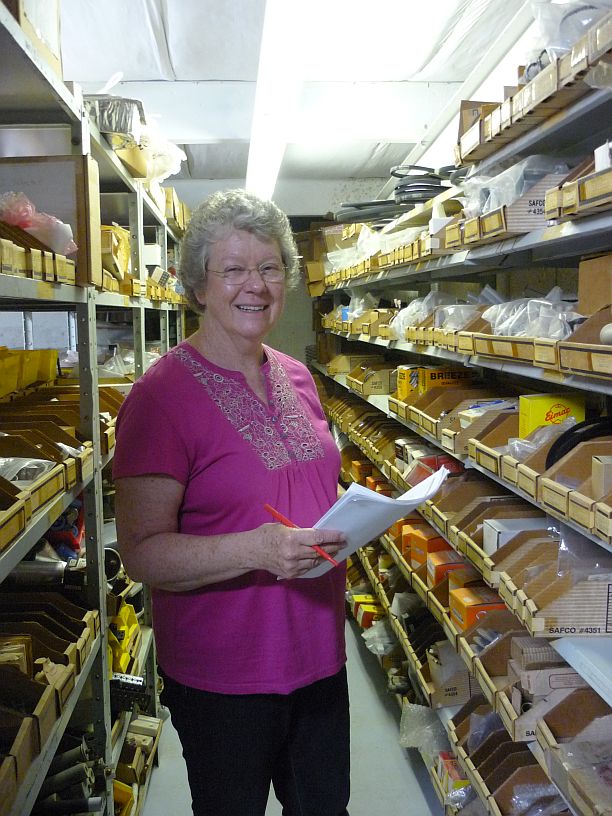
Virginia in the stockroom — most items on the shelf on the right are for the SW100s. Another shelf to the left, but not in this photo is also full of SW100 parts.
With the transmitter sale confirmed, Virginia began working in the stockroom to separate all the spare parts for the SW100s from the spares for the rest of the transmitters.
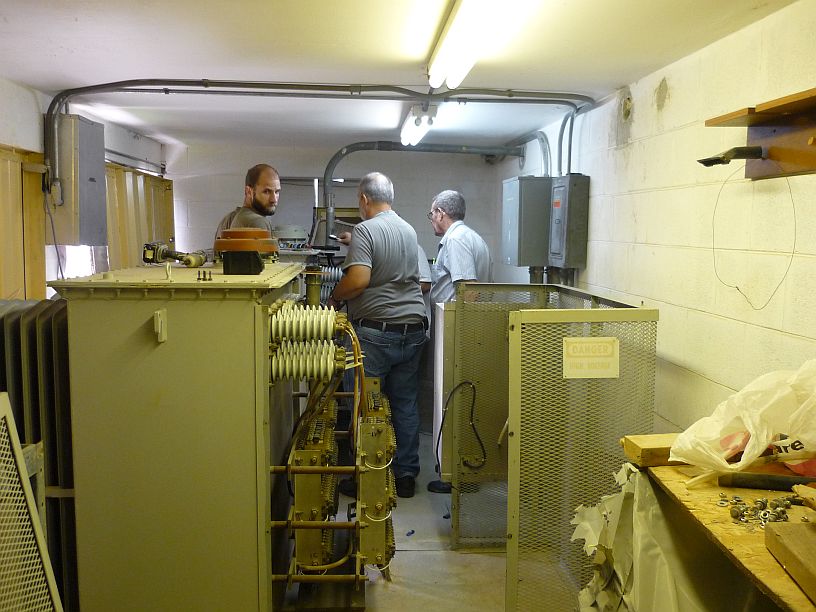
Joel, Phil, Paul (behind Phil) and Larry are disconnecting the two 3-ton high voltage transformers located in a small room behind the transmitters.
Those of us who more technical, began dismantling the SW100s. Today we disconnected and moved out both two 3-ton high voltage plate transformers and several other low voltage transformers, plus regulators, and power distribution boxes.

After removing air vent panels, it was now possible for the 3-ton transformer to be taken out the side of the building. Paul is driving the forklift while Larry observes clearances.
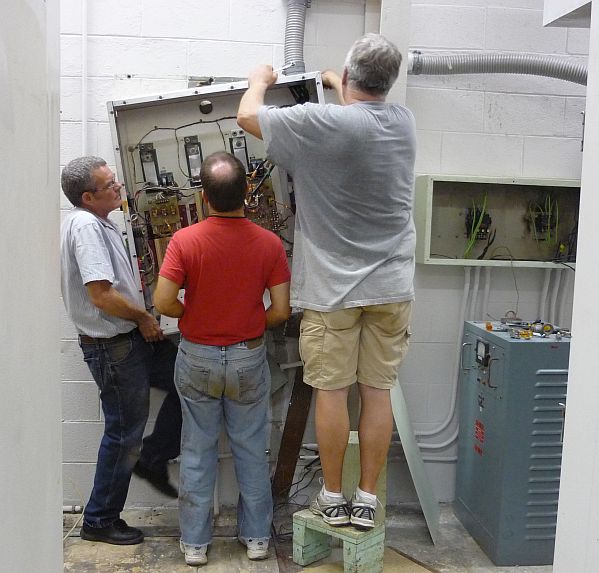
Larry, Mike and Tom (a local pastor) remove one of several power panels from the wall after disconnecting the wiring. One of the regulation transformers is on the floor to the right.
When she wasn’t occupied with work in the stockroom, Virginia helped with some of the moving and took most of the photos in this blog entry.

There are some banana trees located beside the shelter where the 3-ton transformers are temporarily stored.

One stalk of bananas was cut down today and stored in the shop to finish ripening. If left on the tree, they would have been pilfered by other ‘critters’. [Three days later the top half of the stalk is completely yellow.]

Located about 1/2 mile south of our apartment is this MacDonalds which is housed in a 40 foot container. As far as we know, it is one of a kind.

There are three items on the $1 menu — McChicken, cheeseburger and sausage McMuffin. A Big Mac costs $4.99 and $7.49 as a meal.